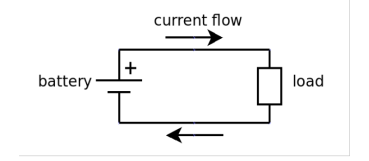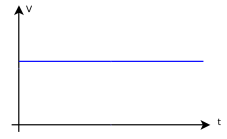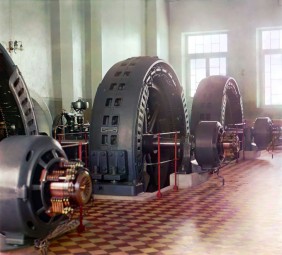
Voltage is a very common word in the context of electrical and electronics engineering. However, common as it is, it is a concept that is often not fully understood.
How many people know that voltage is a concept related with potential energy? The same kind of energy that is so often used in mechanical physics!
When we talked about electrical current in the previous post, we said that current moves from a higher electrical potential energy to a lower one. We also defined the current as the flow of positive charges moving from the positive electrical potential energy to the negative one.

In order for the charges to move, there has to be a force that puts them in motion in a specific direction. Such force will have to do some sort of work on the charges and the work done by the force can be translated in a change in energy of the charges.
We define Electromotive Force the ratio between the energy change of the charges and the amount of charges. This can be represented with the following formula:

Note that, despite the name, the Electromotive Force is not a force in the mechanical sense. Instead it is a potential energy per unit of charge, which we also call electric potential, or just potential.
The unit for the emf is called Volt, and is the ratio between one unit of energy, or 1 Joule, and one unit of charge, or 1 Coulomb:

And that’s where the name voltage comes from: it is a name derived from the measurement unit of the electric potential. Although the correct name is electric potential, to make things easier in the day to day talk, we just call it voltage.
So, again, what is voltage? The voltage is the difference of electrical potential energy that allows a unit of charge to move and produce a current.
Now, do you think it is correct to say that when there is voltage we have a current? Do the two things always go together? Well, the answer is no. You can actually have one without the other.
An example of voltage without a current is the battery. If you don’t connect the battery to a circuit, there is no current involved!

And what about the current? This example is definitively less intuitive. So, let’s just say for now that if we force a current in a ring of a special material called superconductor and then we remove the cause that generated the current, the current keeps flowing in the superconductor, even in the absence of a voltage. Maybe we can explore this concept a little more in a future post, if I see there is an interest for it. Translation: let me know what you think! Comments are always welcome!

Let’s now go back to the battery. The battery provides a voltage between its positive and negative poles. With that, if we connect the battery to an electric load, current starts to flow immediately and the higher the voltage the greater the amount of current (more on that in a future post).

Like the current, there are two forms of voltage:
-
The DC voltage
-
The AC voltage
The DC voltage is the one typically provided by batteries. It is a voltage of a fixed value and of fixed polarity. The plus and minus on the electrodes of the battery never change. One electrode will always be the positive one, and the other electrode will be the negative one.

When we connect a battery to an electric circuit, we have a flow of DC current.
The AC voltage is the one created for example in the power plants and provided at the wall outlets in your house.


The voltage at the outlet is not constant as the one in the batteries. Instead, it changes continuously following the shape of a sine wave. Because of that, the polarity at each electrode of the outlet changes over time from positive to negative and vice versa, following the shape of the sine wave.

When we connect a device to the electric outlet, the current that will flow through that device will be an AC current as well.
The sinusoidal shape of the AC voltage depends on the way the electricity is generated. In the power plants there are devices called alternators, a much bigger version of those that you can find inside your car to recharge the battery, or on a bike, to provide electricity to turn on the lights at night.
Depending on the power plant, a different kind of energy is used to put in motion the alternator. It could be fossil fuel or nuclear energy that heat a reservoir of water and create the steam that makes the alternator rotate.

Or it could be the rotation of a propeller-like device that is put in motion by the wind.

Whatever the source is of the mechanical energy, the alternator converts that energy in electrical energy. But, since the rotation translates into a sine wave when described on a Cartesian reference system, the resulting electrical energy acquires that shape too.
DC and AC are both necessary to us to power devices that make our lives easier. Some devices need to be powered with DC, others need the AC.
DC voltage is necessary, for example, to power electronic devices: your smartphone or radio or computer, for example.
AC voltage is used to transmit the electrical energy from the places where it is created to the places where it is used. When AC reaches our home, it can be used as is to power electric motors like those in the refrigerator or the washing machine, or other household appliance. Or it can be converted to DC to power other devices, like your TV set.
Summarizing:
-
To generate a current, we need to provide some energy to the charges in the conductor.
-
The potential energy per unit of charge is called emf, or electromotive force. That measures the capability of the generator (a battery, for example) of generating a current.
-
Most used synonyms of the emf are: voltage, difference of potential, and potential. Somebody also uses the name “tension”.
-
The measurement unit of the potential is the Volt, which is the potential energy of 1 Joule per unit of charge, or 1 Coulomb.
-
The Volt is a differential measure, not an absolute one. You always measure Volts with respect to a point that we arbitrarily define as 0V, or ground.
-
Emf can be DC or AC and, correspondingly, it can generate a DC or an AC current when connected to an electrical circuit.
-
DC voltage is normally generated through chemical reactions in a battery, or can be obtained from the AC through a process called “rectification”.
-
AC voltage is normally generated with alternators like those used in power plants.
If you want to know more on this topic, I suggest you to watch the companion video of this article, which I posted on my YouTube channel:
https://www.youtube.com/watch?v=vPX-B4xAdtk
Thank you for reading this article and, as always,
Happy Experiments!

